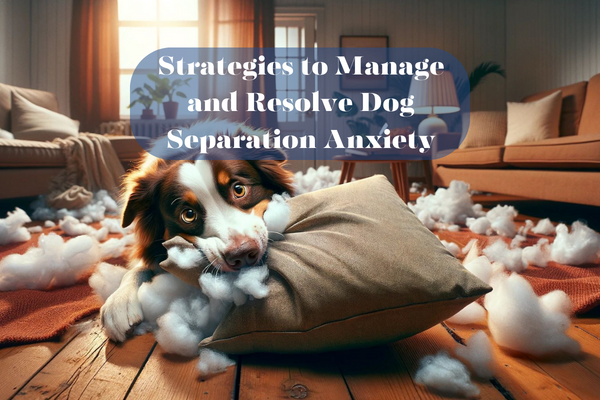
Separation Anxiety in Dogs
What Is Separation Anxiety? Separation anxiety is a widespread problem among pet dogs, which can manifest in several ways. Pets that suffer from separation anxiety may exhibit harmful behaviors like constant barking, destructive chewing, digging, and even soiling inside the house. Some dogs may also become clingy and follow their owners around the house.
My mom experienced this with her chihuahua, Shi. Shi would follow her from room to room underfoot, causing a serious tripping hazard. Let’s delve into the causes of separation anxiety, its symptoms, and, most importantly, practical strategies to manage and alleviate it.
Understanding Separation Anxiety in Dogs: Pets like dogs and cats can experience separation anxiety due to different reasons, such as changes in their routine, a new environment, or past traumatic experiences. Separation anxiety can cause pets to become extremely distressed when they’re separated from their owners or left alone for long periods of time.
Picking up the signs of separation anxiety in your pup shouldn’t be that difficult. Some common signs to look out for include constant barking, howling or whining, destructive activities like chewing or digging, house soiling, and even attempts to escape.
In addition, pets with separation anxiety may become clingy and overly attached to their owners, following them around the house or becoming anxious when their owners prepare to leave the house. Separation anxiety in dogs can cause long-term behavioral problems if not addressed.
To tackle separation anxiety, it’s essential to follow the recommendations below.
Managing Separation Anxiety: Practical Tips and Strategies
Creating a safe and comfortable environment for your dog is paramount. Here are some expanded strategies to help manage and alleviate separation anxiety:
Enhance Your Dog’s Environment
Introduce Comforting Items: Alongside the recommended crates and playpens, consider adding items that carry your scent, such as an unwashed shirt, to your dog’s safe space. This can provide comfort and a sense of security. Products like calming chews, anxiety vests, or diffusers that release calming pheromones can also be beneficial in creating a more relaxing environment for your dog.
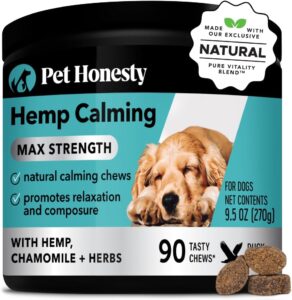 Calming Chews: Consider trying PetHonesty Hemp Calming Anxiety & Solid Gold Calming Chews. These chews are made with natural ingredients like hemp, chamomile, and valerian root, designed to reduce stress and anxiety in dogs without the need for medication.
Calming Chews: Consider trying PetHonesty Hemp Calming Anxiety & Solid Gold Calming Chews. These chews are made with natural ingredients like hemp, chamomile, and valerian root, designed to reduce stress and anxiety in dogs without the need for medication.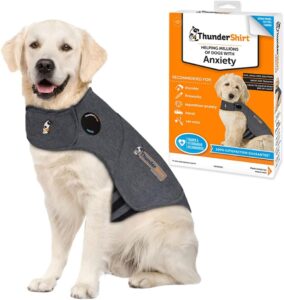 Anxiety Vests: The Thundershirt Classic Dog Anxiety Jacket is a proven solution for anxiety. It applies gentle, constant pressure, similar to swaddling an infant, to help calm your dog during stressful situations, including separation anxiety.
Anxiety Vests: The Thundershirt Classic Dog Anxiety Jacket is a proven solution for anxiety. It applies gentle, constant pressure, similar to swaddling an infant, to help calm your dog during stressful situations, including separation anxiety.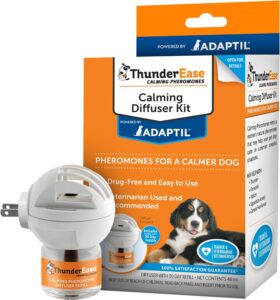 Pheromone Diffusers: The Adaptil Calm Home Diffuser for Dogs mimics the pheromones mother dogs emit to calm their puppies. It’s clinically proven to reduce stress and help dogs feel more relaxed and secure when left alone.
Pheromone Diffusers: The Adaptil Calm Home Diffuser for Dogs mimics the pheromones mother dogs emit to calm their puppies. It’s clinically proven to reduce stress and help dogs feel more relaxed and secure when left alone.
Best Crate Options for Dogs with Separation Anxiety
- MidWest Homes for Pets Crate
- BOLDBONE
- AmazonBasics Single Door Folding Metal Dog Crate
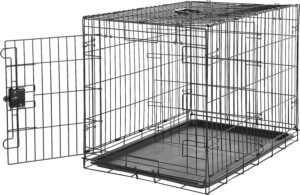
- Amazon Basics Portable Folding Soft Dog Travel Crate Kennel
- SportPet Designs Plastic Kennels
Best Playpen and Washable Pee pad 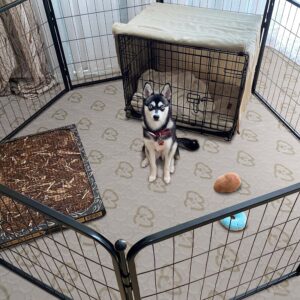
Interactive Toys and Puzzles: Keep your dog mentally stimulated in your absence by providing toys that dispense treats or engage them in puzzle-solving. This can distract them from anxiety triggers.
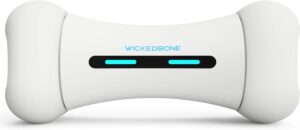 Wickedbone Smart Bone: This interactive toy is a pioneer in pet entertainment, offering automatic play modes that react to how your puppy plays. Durable and safe for pets, the Wickedbone is designed to keep your puppy engaged, with the ability to customize the toy’s responsiveness through a smartphone app. Its ability to toggle between interactive and manual modes allows you to decide whether the toy runs autonomously or is controlled by you, ensuring your puppy is always entertained in a way that suits their energy levels and mood.
Wickedbone Smart Bone: This interactive toy is a pioneer in pet entertainment, offering automatic play modes that react to how your puppy plays. Durable and safe for pets, the Wickedbone is designed to keep your puppy engaged, with the ability to customize the toy’s responsiveness through a smartphone app. Its ability to toggle between interactive and manual modes allows you to decide whether the toy runs autonomously or is controlled by you, ensuring your puppy is always entertained in a way that suits their energy levels and mood.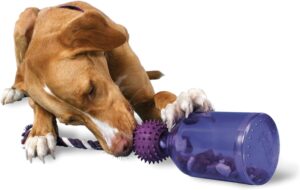 PetSafe Busy Buddy Tug-A-Jug Meal-Dispensing Dog Toy: This innovative toy combines feeding, play, and mental stimulation. The Tug-A-Jug dispenses treats or meals as your puppy interacts with it, rewarding their effort and keeping them engaged for extended periods. The toy’s unique design stimulates your puppy’s senses and encourages active play. Its durable design can withstand the playful energy of both puppies and adult dogs.
PetSafe Busy Buddy Tug-A-Jug Meal-Dispensing Dog Toy: This innovative toy combines feeding, play, and mental stimulation. The Tug-A-Jug dispenses treats or meals as your puppy interacts with it, rewarding their effort and keeping them engaged for extended periods. The toy’s unique design stimulates your puppy’s senses and encourages active play. Its durable design can withstand the playful energy of both puppies and adult dogs.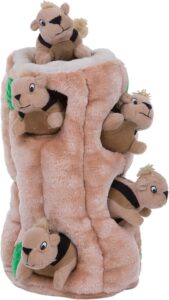 Outward Hound Hide A Squirrel Puzzle Toy: Outward Hound Hide A Squirrel Puzzle Toy was designed to challenge your puppy’s problem-solving skills; this plush puzzle toy stimulates mental play with its hide-and-seek design. The game involves hiding plush squirrels inside a soft tree trunk and encouraging your puppy to find them. This keeps your puppy occupied and develops their hunting and retrieval instincts. The interchangeable puzzle pieces add to the toy’s versatility, providing endless entertainment for your pet.
Outward Hound Hide A Squirrel Puzzle Toy: Outward Hound Hide A Squirrel Puzzle Toy was designed to challenge your puppy’s problem-solving skills; this plush puzzle toy stimulates mental play with its hide-and-seek design. The game involves hiding plush squirrels inside a soft tree trunk and encouraging your puppy to find them. This keeps your puppy occupied and develops their hunting and retrieval instincts. The interchangeable puzzle pieces add to the toy’s versatility, providing endless entertainment for your pet.- Woof Pupsicle Fillable Dog Toy
- Outward Hound Interactive Treat
- Starmark Bob-a-Lot Treat Toy
Step-by-Step Guide to Reduce Separation Anxiety Through Gradual Desensitization
Gradual desensitization is a crucial technique in training dogs to feel secure and calm when left alone. This method involves slowly and gently acclimatizing your dog to solitude, ensuring they associate being alone with positive experiences. Follow these detailed steps to effectively implement this approach:
- Preparation for Alone Time:
- Begin by choosing a comfortable and secure space for your dog, such as a crate or playpen, which will serve as their safe haven. The area should be familiar to them, free from stressors, and equipped with their favorite blanket or bed.
- Ensure the space has ample water and a comfortable resting area. This setup aims to make the area as inviting as possible, reinforcing the idea that it’s a pleasant place to be, even in your absence.
- Introduction to Solitude:
- Start with very short durations of separation, as brief as a few minutes. The key is to not trigger anxiety but to introduce the concept of being alone gently.
- Leave the room quietly without creating a dramatic scene. The goal is to normalize the process of you leaving and returning.
- Engagement During Alone Time:
- To make this experience as positive as possible, leave engaging toys or chew treats that they particularly enjoy. Items that are safe for unsupervised play and can keep them occupied are ideal, such as treat-dispensing toys or durable chew toys.
- These toys should be special treats that they only get when they’re alone, making alone time something to look forward to.
- Monitoring and Adjusting to Your Dog’s Response:
- It’s normal for your dog to show some signs of unease or anxiety at first. Monitor their behavior from a distance if possible, using a pet camera or by listening for cues of distress.
- If they become anxious, wait for a moment when they’ve settled down before you return. This teaches them that calm behavior is what brings you back.
- Positive Reinforcement Upon Return:
- When you return to their space, keep your greeting calm and low-key. Overexcitement can make departures more stressful for your dog.
- Reward them with a small treat or affection for calm behavior. This positive reinforcement helps them associate your departure and return with good things.
- Gradually Increasing Alone Time:
- Slowly extend the time your dog spends alone, starting from a few minutes and gradually increasing to longer periods. Pay close attention to your dog’s reaction to each increment to ensure they’re not overwhelmed.
- The progression should be based on your dog’s comfort level, not a predefined timeline. Some dogs may adjust quickly, while others may need more time to acclimate.
- Consistency and Patience:
- Repeat this process consistently, aiming for several sessions throughout the day. Consistency helps solidify the training, making each successful session a step towards overcoming their anxiety.
- Be patient and understanding. Progress may be slow, but with time and consistency, most dogs can learn to be comfortable being alone.
Remember, you don’t have to go through this alone – there is support available to you!
Seek Professional Help
Consult a Veterinarian: A vet can assess whether your dog’s anxiety might have a medical cause and discuss the possibility of medication to help ease their anxiety.
Behavioral Therapy: A professional dog behaviorist can offer personalized strategies and support to help your dog overcome their anxiety. This might include systematic desensitization and counterconditioning techniques tailored to your dog’s specific needs.
Advanced Training Technique
Counterconditioning: This involves changing your dog’s anxious response to a positive one by associating your departure with something good, like a favorite treat or toy that they only get when you’re away.
Success Stories and Community Support
Sharing success stories can be incredibly empowering for pet owners navigating the challenges of separation anxiety. Whether it’s through online forums, social media groups, or local pet owner meetups, connecting with others who have successfully managed their dog’s separation anxiety can provide valuable insights and encouragement.
Managing separation anxiety in dogs requires patience, consistency, and a compassionate understanding of your dog’s needs. By creating a safe space, utilizing interactive toys, establishing a routine, and possibly seeking professional help, you can significantly improve your dog’s quality of life and strengthen your bond. Remember, each dog is unique, and what works for one may not work for another. It’s about finding the right combination of strategies that suit your dog’s individual needs. If you’re struggling with your dog’s separation anxiety, know that you’re not alone, and with the right approach, improvement is possible. For more insight on interactive toy and monitoring devices check out Integrating Puppy Care with Smart Home Devices.
This article may contain affiliate links. As an Amazon Associate, I earn from qualifying purchases.